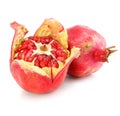Designed by
Title
pomegranate fruit #291215760
Description
PomegranateFruit of Punica granatum split open to reveal clusters of seeds with sarcotesta on the inside, and a glass of juiceThe pomegranate (Punica granatum) is a fruit-bearing deciduous shrub in the family Lythraceae, subfamily Punicoideae, that grows between 5 and 10 m tall.Young pomegranate tree in Side, TurkeyThe pomegranate was originally described throughout the Mediterranean region. It was introduced into Spanish America in the late 16th century and into California by Spanish settlers in 1769. They are widely cultivated throughout the Middle East and Caucasus region, north and tropical Africa, the Indian subcontinent, Central Asia, the drier parts of Southeast Asia, and the Mediterranean Basin. The fruit is typically in season in the Southern Hemisphere from March to May, and in the Northern Hemisphere from September to February.As intact sarcotestas or as juice, pomegranates are used in baking, cooking, juice blends, meal garnishes, smoothies, and alcoholic beverages, such as cocktails and wine.EtymologyA pomegranate tree in an illustration for the Tacuinum Sanitatis, made in Lombardy, late 14th century (Biblioteca Casanatense, Rome)The name pomegranate derives from medieval Latin p?mum "apple" and gr?n?tum "seeded".[7] Possibly stemming from the old French word for the fruit, pomme-grenade, the pomegranate was known in early English as "apple of Grenada"âa term which today survives only in heraldic blazons. This is a folk etymology, confusing the Latin granatus with the name of the Spanish city of Granada, which is derived from an unrelated Arabic word.[8]A shrub or small tree growing 5 to 10 m (16 to 33 ft) high, the pomegranate has multiple spiny branches and is long-lived, with some specimens in France surviving for 200 years. granatum leaves are opposite or subopposite, glossy, narrow oblong, entire, 3â7 cm long and 2 cm (3?4 in) broad. The flowers are bright red and 3 cm in diameter, with three to seven petals.[4] Some fruitless varieties are grown for the flowers alone.
















